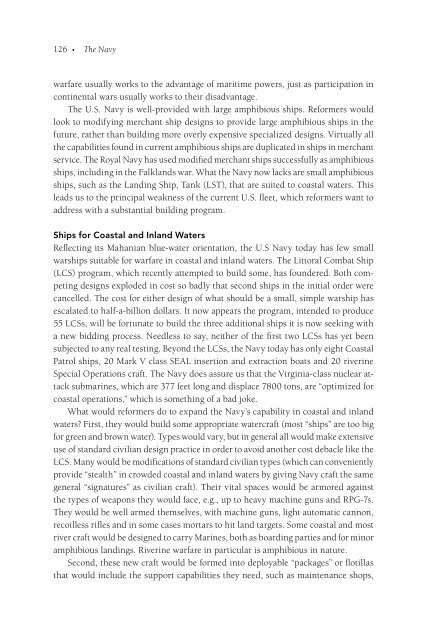Americas Defense Meltdown - IT Acquisition Advisory Council
Americas Defense Meltdown - IT Acquisition Advisory Council
Americas Defense Meltdown - IT Acquisition Advisory Council
Create successful ePaper yourself
Turn your PDF publications into a flip-book with our unique Google optimized e-Paper software.
126 • The Navywarfare usually works to the advantage of maritime powers, just as participation incontinental wars usually works to their disadvantage.The U.S. Navy is well-provided with large amphibious ships. Reformers wouldlook to modifying merchant ship designs to provide large amphibious ships in thefuture, rather than building more overly expensive specialized designs. Virtually allthe capabilities found in current amphibious ships are duplicated in ships in merchantservice. The Royal Navy has used modified merchant ships successfully as amphibiousships, including in the Falklands war. What the Navy now lacks are small amphibiousships, such as the Landing Ship, Tank (LST), that are suited to coastal waters. Thisleads us to the principal weakness of the current U.S. fleet, which reformers want toaddress with a substantial building program.Ships for Coastal and Inland WatersReflecting its Mahanian blue-water orientation, the U.S Navy today has few smallwarships suitable for warfare in coastal and inland waters. The Littoral Combat Ship(LCS) program, which recently attempted to build some, has foundered. Both competingdesigns exploded in cost so badly that second ships in the initial order werecancelled. The cost for either design of what should be a small, simple warship hasescalated to half-a-billion dollars. It now appears the program, intended to produce55 LCSs, will be fortunate to build the three additional ships it is now seeking witha new bidding process. Needless to say, neither of the first two LCSs has yet beensubjected to any real testing. Beyond the LCSs, the Navy today has only eight CoastalPatrol ships, 20 Mark V class SEAL insertion and extraction boats and 20 riverineSpecial Operations craft. The Navy does assure us that the Virginia-class nuclear attacksubmarines, which are 377 feet long and displace 7800 tons, are “optimized forcoastal operations,” which is something of a bad joke.What would reformers do to expand the Navy’s capability in coastal and inlandwaters? First, they would build some appropriate watercraft (most “ships” are too bigfor green and brown water). Types would vary, but in general all would make extensiveuse of standard civilian design practice in order to avoid another cost debacle like theLCS. Many would be modifications of standard civilian types (which can convenientlyprovide “stealth” in crowded coastal and inland waters by giving Navy craft the samegeneral “signatures” as civilian craft). Their vital spaces would be armored againstthe types of weapons they would face, e.g., up to heavy machine guns and RPG-7s.They would be well armed themselves, with machine guns, light automatic cannon,recoilless rifles and in some cases mortars to hit land targets. Some coastal and mostriver craft would be designed to carry Marines, both as boarding parties and for minoramphibious landings. Riverine warfare in particular is amphibious in nature.Second, these new craft would be formed into deployable “packages” or flotillasthat would include the support capabilities they need, such as maintenance shops,


